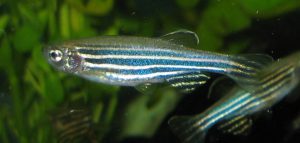Hometown: Freshwater ponds and rivers of India, Nepal, and neighboring countries
Occupation: Research
Long-term goal: Solving the basic mysteries of life
Work site: More than 600 science labs worldwide

That’s me and some other zebrafish, swimming in a tank in one of the more than 600 labs around the world that use us to study embryo development, genetics, and all kinds of human diseases. Credit: Wikimedia Commons, Azul.
Apart from the tell-tale stripes that give me my nickname, zebrafish, I look a lot like your standard minnow swimming in the shallows of any pond, lake, or river. But I like to think I’m more important than that. In fact, researchers around the world have turned to me and my extended family to understand some of the most basic mysteries of life. From studying us, they’re learning about how embryos develop, how cancer works, and whether someday humans might be able to rebuild a heart, repair a spinal cord injury, or regrow a severed limb.
Why us? Because zebrafish are pretty special and researchers think we’re easy to work with. First, unlike your standard lab mouse or rat, we lay lots of eggs, producing baby fish that grow up fast. We develop outside our mothers and go from egg to embryo to free-swimming larva in just 3 days (check out this video ![]() of how we grow, cell by cell, during the first 24 hours). Within 3 months, we’re fully mature.
of how we grow, cell by cell, during the first 24 hours). Within 3 months, we’re fully mature.
Not only do zebrafish moms have many babies at the same time, and not only do these babies grow up quickly, but our eggs and embryos are see-through, so scientists can literally watch us grow one cell at a time. We stay mostly transparent for a few weeks after hatching. That makes it super easy for scientists to monitor us for both normal and abnormal development. In fact, scientists have learned how to turn off the genes that give our skin its color. These zebrafish, named casper, after the “friendly ghost” of cartoon fame, stay semi-transparent, or translucent, through adulthood.
And last, but certainly not least, did I mention that we can regenerate? If parts of my body are damaged, even to a significant degree, they can regrow. This holds true for my heart, fins, spinal cord, and even brain tissue. Our regenerative capacity is seemingly unlimited; my caudal fin, for example, can grow back dozens of times.
We don’t look much like humans. But we aren’t as different as you think. We’re both vertebrates, with a central spinal column, and we have the same major organs and tissues. And we have lots of similar genes. Seventy percent of human genes have a least one close match to our genes.
Although a few researchers in Oregon started working with us in the 1970s, we really skyrocketed into science labs in the mid-1990s, when a huge study ![]() of my cousins identified 4,000 genetic mutations—small changes in different genes that could alter how those genes work. Researchers like working with organisms with mutated genes because this lets them more easily understand normal genes. They can compare fish with an abnormal copy of a gene with fish that have a normal copy. We became even more popular when, in 2013, scientists sequenced all of a zebrafish’s genes
of my cousins identified 4,000 genetic mutations—small changes in different genes that could alter how those genes work. Researchers like working with organisms with mutated genes because this lets them more easily understand normal genes. They can compare fish with an abnormal copy of a gene with fish that have a normal copy. We became even more popular when, in 2013, scientists sequenced all of a zebrafish’s genes ![]() .
.
I hope you enjoy this scrapbook. It shows some of my favorite pictures of my kin hard at work in the lab. These snapshots demonstrate just how important we are to research that can promote human health and potentially help treat and prevent human disease.
Click on an image below to launch slideshow.








Thank you so much for this nice piece about our friend the zebrafish. I have won a $5000 grant from Regeneron Science in Society and the Public so my students can conduct research projects with the zebrafish. I have built a low cost zebrafish facility that holds 90 tanks. We are all very excited to be doing this woek in a high school.
That’s great! Good luck with the research.
Congratulations for this medía work. Resarches from several parts, develop scientistic resources for doing the best of the human being life and the media bring all of these to the world.
Thank you for expanding my knowledge so effectively. My sons call me an infoholic and I became drunk reading your article.